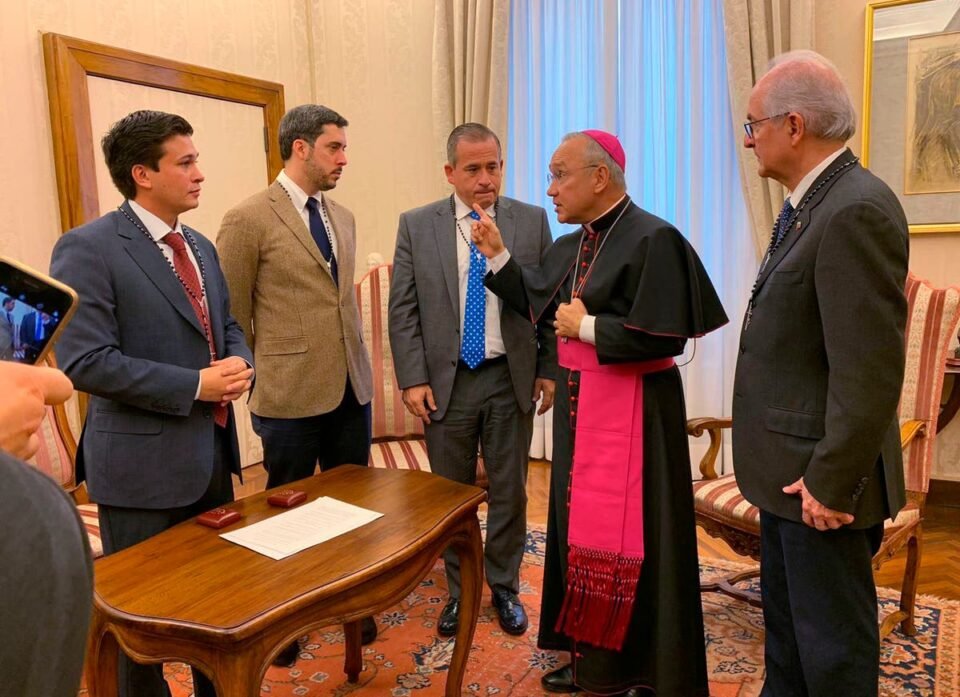Pope Francis’ chief of staff became one of the highest-ranking Holy See officials to testify in a foreign court Thursday, giving a British tribunal a detailed explanation of the negotiations at the heart of the Vatican’s so-called “trial of the century” and pointing a finger at his onetime deputy who escaped the scandal unscathed.
Archbishop Edgar Pena Parra was called to testify in a British civil proceeding brought against the Vatican by an Italian-British financier who was involved in the Vatican’s investment in a London property.
Raffaele Mincione is seeking to clear his name in the British courts after he was convicted by a Vatican criminal tribunal last year for his role in the Vatican’s 350 euro (US$375 million) investment in the former Harrod’s warehouse. He is asking the British High Court to declare he acted “in good faith.”
The London case, believed to be the first time the Holy See has been put on trial in a foreign court, is part of the collateral damage that the Vatican has incurred in deciding to prosecute 10 people for a range of financial crimes surrounding its money-losing London investment.
Vatican prosecutors accused Mincione and others of fleecing the Holy See of tens of millions in euros in fees and commissions. Another London broker, Gianluigi Torzi, was accused of then extorting the Vatican for 15 million euros to cede control of the building. They were both convicted by the Vatican court, along with seven others including a cardinal, and are appealing.
In his written opening statement in London, Pena Parra provided a detailed play-by-play of the frenzied meetings, WhatsApp messages and negotiations in late 2018 when the property changed hands from a fund controlled by Mincione to a holding company controlled by Torzi.
The Holy See had engineered that transaction after it lost faith in Mincione and decided to entrust the property to Torzi’s management. Vatican prosecutors say Torzi, however, hoodwinked the Vatican and assumed all the voting shares in the holding company for himself.
Torzi, Mincione and the other defendants in the Vatican trial argued the Holy See was perfectly aware of the risks of its investment and understood the terms of the transactions, which they said were all approved by top officials including Pope Francis.
Pena Parra barely mentioned Mincione in his written statement Thursday, since he only joined the Vatican as “substitute” in the secretariat of state in October 2018, a month before the property passed to Torzi.
His written filing focused instead on his deputy who oversaw the entire investment. Monsignor Alberto Perlasca headed the administrative office that proposed and approved the original investment with Mincione in 2013; Perlasca then signed the contracts giving Torzi control of the property five years later.
Perlasca’s fate has been one of the lingering anomalies of the London saga. He was never prosecuted for his role in the deal, whereas his underlings and bosses were, and he reportedly has resumed working as prosecutor himself in the Holy See’s highest ecclesial court, the Apostolic Signatura.
It’s an unusual outcome given evidence that emerged during the Vatican trial that Perlasca had acted without authorization in signing the contracts with Torzi and then was coached, manipulated and threatened by two mysterious women to change his story once Vatican prosecutors began investigating.
Some defense lawyers suspect that Perlasca or the women have incriminating evidence against Vatican figures and are using that information to ensure Perlasca escapes unscathed. Mincione’s lawyers noted that the Vatican didn’t make Perlasca available for the London trial, where he would have been subject to cross-examination, chosing Pena Parra instead.
Pena Parra’s testimony made clear that he only learned from Perlasca of the existence of the London investment on Nov. 22, 2018, the same day Perlasca signed the contracts with Torzi without authority.
“I had put trust in the officials of the administrative office, and I had never expected this kind of conduct. I felt betrayed,” he said in his prepared statement.
By December, Pena Parra realized the Holy See had essentially acquired an “empty box,” since Torzi controlled the building, and was weighing whether to sue him or negotiate an exit strategy to get control of the property. The Vatican’s lawyers advised against litigation, since the outcome was uncertain given Perlasca’s signed contracts.
Pope Francis “asked me to keep two things in mind: namely that we should try to lose the least amount possible and that we had to leave this business behind us and start over,” Pena Parra said.
He said during a Dec. 26 private meeting he had with the pope, “it was agreed” that the Vatican would offer to pay Torzi 1 million-2 million pounds for control of the building. Torzi eventually demanded and received 15 million euros — a payment that became the basis for his extortion conviction.


